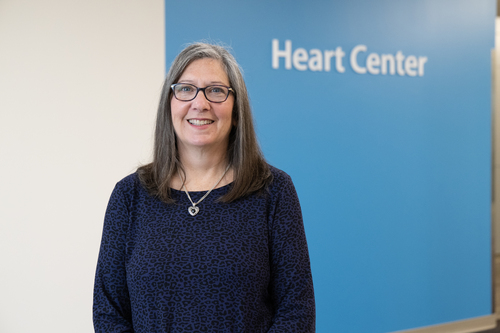
Deena Barber
Deena Barber, nurse program coordinator for the Adult Congenital Heart Disease (ACHD) program, has seen a lot of change in her 36 years as a nurse at Akron Children’s. But one thing that hasn’t changed in all that time is how she treats her patients.
“My most important responsibility is to alleviate fear,” she said.
Whether that was as a Burn Center nurse back in 1986 or in her current role, it still rings true.
“I remind myself of this with every encounter, no matter how short or long. My role is to help my patients any way I can,” she said.
That may be as simple as explaining what will happen the day of a patient’s visit, to as complex as explaining life expectancy outlook.
“I try very hard to understand my patients’ fears and what I can do to help them since CHD is a lifelong, chronic health condition with no cure,” she said.
Deena has been providing nursing care for adults with congenital heart disease for almost 20 years. She has been the nurse program coordinator for the last 10 years and is responsible for the day-to-day clinical aspect of the program.
“I see patients most days,” she said. “I’m responsible for patient calls, MyChart messages, internal and external referrals, staff questions, patient education, care coordination across facilities, CHD advocacy and CHD research.”

Congenital heart disease is the No. 1 birth defect with 1 in 100 babies born with it. As medical care and treatments have improved, babies and children with CHD are living longer and healthier lives.
In addition to adult patients, Deena also works with pediatric patients transitioning into the Adult Congenital Heart Service.
“Transition is a multiyear process, educating and preparing our patients to care for themselves in adulthood,” she said. “We begin the process at age 12.”
An individualized education and transition plan is formulated after review of the Congenital Heart Disease Transition Readiness Assessment, which is a tool completed by the patient yearly.
“Topics discussed are appropriate to the chronological and developmental age of the patient,” said Deena. “Families, caregivers and loved ones are included in the transition process.”
Transition includes transfer of care to the Adult Congenital Heart Service, usually by age 21. The transfer of care is decided between the patient, their pediatric cardiologist and the family.
“We’re thrilled to be able to maintain care in a familiar, comfortable setting with seamless continuity,” said Deena.
As medical care and treatments have improved, babies and children with CHD are living longer and healthier lives. More adults are alive with CHD than children, due in part to medical advancements. The oldest patient in Akron Children’s program is 72 years old.
“Medical, surgical and procedural technology grows daily,” said Deena. “I encourage my families to rely on their cardiac team and communicate with them because they are in it for the long haul, not just today.”

CHD patients are encouraged to take care of their mental health through yoga and meditation because they often suffer from a higher rate of anxiety and depression than the general population.
Outside of medical interventions and medications, CHD treatment also takes a holistic approach.
“I discuss heart healthy lifestyle choices, especially the importance of physical activity,” Deena said. “I often suggest yoga and meditation, things most patients can do in the comfort of their own home. Encouraging a patient to take care of their mental health is part of every visit because we know ACHD patients suffer from anxiety and depression at a higher rate than the general population.”
Deena said ACHD patients are often misunderstood by the medical community since many caregivers are not familiar with them.
“I teach patients to advocate for themselves and always remain in touch with their ACHD team with questions and concerns,” she said. “I want them to know I truly see them, past their CHD to them as a person.”
Congenital heart disease is the No. 1 birth defect with 1 in 100 babies born with it.
“My patients are survivors and warriors. My goal is to help them not only survive but thrive,” said Deena. “I will fight alongside them every step of the way.”
Visit akronchildrens.org for more information on CHD or the Adult Congenital Heart Program.










